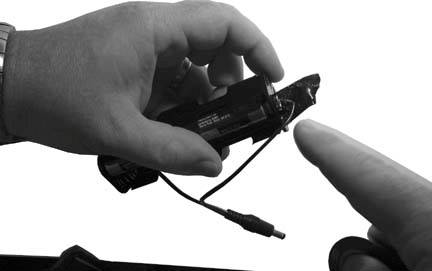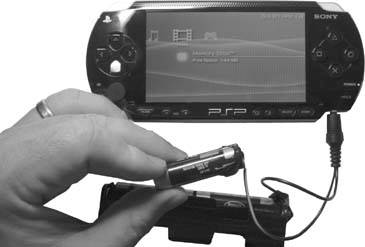Hack15.Make a Battery Pack for Your PSP
Hack 15. Make a Battery Pack for Your PSP
This hack will build an external battery pack for the PSP to extend the internal battery pack's life from the just-a-bit-too-short three to six hours. Sure, you could plop down a load of cash for some company's prepackaged external battery for your PSP if you need to extend the battery life of your PSP while you're on the go. Lik Sang (http://www.lik-sang.com/) offers both the third-party External 3800mAh Battery Pack for PSP for $24.95 USD (http://www.lik-sang.com/info.php?category=307&products_id=7027) and the third-party Clip-on 1800mAh Battery Pack for PSP for $14.95 USD (http://www.lik-sang.com/info.php?category=307&products_id=7026). If you speak Japanese, you could probably figure out how to order the My Battery JET for PSP (http://www.watch.impress.co.jp/game/docs/20050603/jtt.htm), and if Chinese is your cup of tea, the DragonPlus Rechargeable Handle Pad, which turns your PSP into one big controller (http://www.chinapsp.net/Default.aspx?tabid=888&DocType=ArticleView&ArticleID=990). And, of course, you could always invest in another Sony battery for the PSP and swap them out while you are on the go. As I write this hack, these are just a few of the commercially available options to extend the battery life of your PSP. There will surely be more and more options in the weeks and months to come. But, you're reading PSP Hacks. You want to do something "hackish." Wouldn't you rather just grab an old AC adapter and some other odds and ends from around the house to hack together your own battery charger for the PSP? Me too. My sister-in-law, Maggie, just recently received her Biomedical Engineering B.S. with a concentration in electrical work from Columbia University, so I enlisted her help for this hack. Overkill? Of course.
2.5.1. Things You'll Need
2.5.2. The Theory Behind the HackThe transformer in the PSP's AC/DC converter adjusts your regular household voltage down to a whopping five volts, which trickles slowly into your PSP, charging the internal, Sony-supplied battery. Why don't they beef up this voltage into the machine so that the charging goes faster, you ask? Well, mini power surges aside, any voltage higher than five volts could very quickly, with a sizzle and a burnt smell, fry up your PlayStation Portable into a very handy PlayStation doorstop or paperweight. 2.5.3. Setting Things UpThe battery holder we had on hand was designed to hold eight AA batteries in series, putting out a whopping 12 volts of power, which is much higher than the 5 volts needed by the PSP and would risk frying our little gaming wonder. Each AA battery puts out 1.5 volts, so some quick math told us that three AA batteries would get us up to 4.5 volts, which is the ballpark we need to be playing in. We looked at the connected flow of the batteries through the battery holder and stacked two on one side, and then one alone on the adjacent side. Three 1.5-volt AA batteries in a line tested at 4.86 volts with the multimeter, which was perfect, falling just shy of the five volts indicated on the PSP. Next, we found an AC adapter from an old, broken CD player that was lying around the house. The AC adapter was rated at six volts, and the plug fit perfectly into the PSP.
We then took our wire strippers and cut the AC cord from the plug, several inches away from the piece that would be plugged into the PSP. Make sure that you give yourself enough length to work with here. Remember, you can always cut more off, but you can't add back on without some ugly line splicing. The line coming from the plug is actually two different wires stuck together: one to carry the negative current and the other to carry the positive. Pull the two wires apart. After they are separated, strip off about a quarter inch of plastic from the ends. For each of the wires, twist the little copper wires together so they look more like a solid wire without any stray hairs sticking out. 2.5.4. Assembling the PackNow, take the battery holder and put three batteries in so that the current will flow from negative to positive. Where the batteries will need to be placed will vary depending upon the battery holder you have, so pay attention to the connection between the different sections. For our battery holder, we had two batteries stacked in a row on one side, while one sat alone on the adjacent corner. To make a complete circuit that will charge the PSP, the negative line from the adapter plug (the negative wire will usually have a white stripe down the side of it) will need to be attached to the negative end of the line of batteries, and the positive line from the adapter (which will sometimes be red) will need to be attached to the positive end of the line of batteries.
For both of these connections, we used simple electrical tape. For the negative connection, we attached the wire to the negative contact on the outside of the battery holder (see Figure 2-39). Figure 2-39. Taping the negative line to the negative plug on the battery holder Then, for the positive connection, we simply taped the wire to the positive top of the AA battery that was sitting solo on the other side and shoved it in with the tape, which helped hold it in place (see Figure 2-40). Figure 2-40. Popping the battery into place When we plugged it in, a nice orange light showed up on the PSP and the battery indicator light began to flash on and off on the PSP's screen, indicating that it was receiving a charge. 2.5.5. Hacking the HackNow, our battery pack works, but the current coming from it isn't enough to power the PSP if the internal battery runs out. It is an ugly, horrible shadow hack of what it could be. When the PSP is turned on, it isn't actually managing to charge the PSP; rather, it is working as a battery extender of sorts, extending the length of the internal battery's charge by subsidizing the energy that is powering the PSP. If the PSP is turned off, however, this pack will push energy into the PSP, albeit slowly. Ideally, if we were building a battery pack out of three AAs, which we were, we'd get a holder made for three AA batteries rather than one built to hold eight. With a fully loaded holder, we could actually solder the positive and negative wires onto the positive and negative outputs from the holder to ensure a tight circuit through which the power can flow. As is, depending upon how much electrical tape we used on the last battery to thicken it up and how nicely we wedged it into place, from time to time the battery will shift out on the spring that it is resting up against, and the circuit will disconnect until we get it back into place. Also, since we chose to use electrical tape rather than hardwiring everything together nicely, there is the ever-present possibility of the wires ripping free.
Now, beyond these physical concerns, the flow of current coming from this battery pack is far below what the PSP ideally needs. If we really wanted to make a professional battery pack, we would grab a battery with larger voltage, such as a 9-volt remote control car battery. In order to prevent the nine volts from frying the 5-volt plug in the PSP, we'd need to attach a 5-volt regulator (like a +5V Fixed-Voltage Regulator 7805 from RadioShack, catalog part # 276-1770, which is capable of a maximum input of 35VDC and puts out +5V at up to 1 amp) between the battery and the wires leading to the plug. The larger battery voltage would in turn provide higher amperage and, therefore, a higher flow of current, and the 5-volt regulator would keep the current capped at five volts, which would protect us from frying our PSP. If you opt for this setup, you should probably stick a heat sink on the regulator, since regulators tend to fry and the heat sink will keep the regulator from overheating. Be careful to properly connect input, output, and the ground connectors on the regulator, and if you're not too good with soldering, either grab a solderless breadboard from RadioShack or find a guru friend to do it for you, since you could accidentally short the regulator in the process. Soldering will ensure connections, but the breadboard will allow for easy replacement of the regulator should it short out (which, as mentioned previously, they are prone to do). Choose wisely. |
EAN: 2147483647
Pages: 108
- Integration Strategies and Tactics for Information Technology Governance
- An Emerging Strategy for E-Business IT Governance
- Assessing Business-IT Alignment Maturity
- A View on Knowledge Management: Utilizing a Balanced Scorecard Methodology for Analyzing Knowledge Metrics
- The Evolution of IT Governance at NB Power
